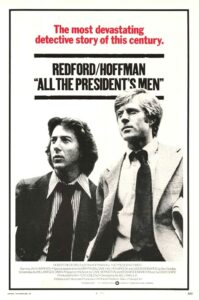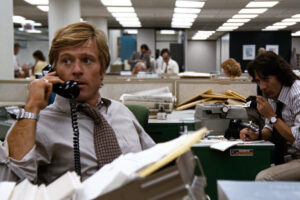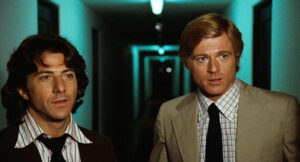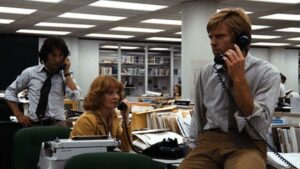“All the President’s Men” – Behind the Scenes of the Watergate Scandal

Title: “All the President’s Men”
Release Date: 1976
Director: Alan J. Pakula
Cast: Robert Redford, Dustin Hoffman, Jason Robards, Jack Warden, Hal Holbrook
When, on August 9, 1974, the then President of the United States – Richard Nixon – resigned, the American public not only did not hide its indignation at this fact, but, above all, lost confidence in the institutions holding power in the country. The reason for such a situation was the notorious Watergate affair, for the exposure of which two journalists of the newspaper “The Washington Post” – Carl Bernstein and Bob Woodward – were responsible.
Their bestselling book – describing the backstage of this political scandal – “All the President’s Men”, published in 1974, became the basis for the screenplay of the American feature movie of the same name. The roles of the indomitable reporters were played by Robert Redford and Dustin Hoffman, with paranoid thriller expert Alan J. Pakula behind the camera. The result of their collaboration is the picture “All the President’s Men”, which, 46 years after its premiere, still stirs up great emotions and is considered a precursor in terms of productions dealing with the subject of journalism.
“All the President’s Men” – plot outline
Two reporters of “The Washington Post” newspaper – Carl Bernstein and Bob Woodward, come across by chance surprising information about the break-in at the Watergate complex, where the headquarters of the US Democratic Party election headquarters in Washington is located. According to the reporters’ findings, on the night of June 17, 1972, there was an attempt to illegally plant a wiretap there. Five people were detained – the so-called “plumbers” – led by Presidential Reelection Committee staffer James McCord. This state of affairs caused great concern, casting suspicion that people located at the highest levels of the state administration were behind this illegal operation.

In addition to the aforementioned James McCord, the burglary team will include Virgilio Gonzales, Eugenio Martinez, Bernard Parker and Frank Sturgis. Carl Bernstein and Bob Woodward begin an arduous investigation fraught with many hectic situations, and a significant number of people, willing to reveal many relevant facts about the true motivations of the President’s henchmen, will make them believe that they are on the right track to solving the mystery. The breakthrough in the investigation will turn out to be information received from a mysterious stranger using the alias “Deep Throat.”
“All the President’s Men” – groundbreaking picture about journalism
The film “All the President’s Men” is the last of the three parts of the so-called “paranoid trilogy”, directed by Alan J. Pakula, which also includes “Klute” with an Oscar-winning performance by Jane Fonda and “The Parallax View” with Warren Beatty. During Richard Nixon’s presidency, which fell between January 20, 1969, and August 9, 1974, a series of images were produced in a dark style, characterized by an atmosphere of constant confusion and distrust of government authorities. The series of three film works connected thematically, rather than plot-wise, stood in stark opposition to works made in the 1970s, in the United States.
At the time, productions with mafia, war and science fiction themes reigned supreme in American cinemas. “The Godfather” by Francis Ford Coppola, “The Deer Hunter” by Michael Cimino, “Star Wars” by George Lucas and “Alien” by Ridley Scott are just some of the most flagship blockbusters enjoying great success at the time, but nevertheless paranoid thrillers – characterized by a higher degree of realism and a lower level of accessibility relative to the bestsellers of the time – also managed to make their mark on the cinematic firmament.

The picture “All the President’s Men” is unique not only because of the realization craftsmanship and the subject matter taken up, but most importantly, it presents the course of a journalistic investigation in an extremely detailed and transparent manner. Alan J. Pakula’s movie watches like a first-class action movie, in which firearms have been replaced by writing instruments, and the lack of chases and shootouts is compensated for by dynamic dialogues. Particularly noteworthy are the sequences shot in the impressively sized office of “The Washington Post” newspaper, where Woodward and Bernstein, fortified with notes and drowning in the sound of telephones, try to reconstruct the course of events of the entire affair as accurately as possible and, on this basis, draft an article exposing the unlawful activities of the president and all his men involved in this criminal enterprise.
The person responsible for generating the gloomy atmosphere in Alan J. Pakula’s picture is an American cinematographer – Gordon Willis, with whom the director has worked before, on the occasion of the first two episodes included in the “Paranoid Trilogy”. In addition, the artist is responsible for the cinematography of the “Godfather” saga, directed by Francis Ford Coppola, and for several Woody Allen films, with “Annie Hall” and “Manhattan” at the forefront. In 2010 he was honored with a Special Oscar for his invaluable contribution to cinema.
Robert Redford and Dustin Hoffman – playing the roles of Bob Woodward and Carl Bernstein
“All the President’s Men” is one of the first and also the best pictures showing the hardships of the journalistic profession. Much credit for this goes to the actors playing the main roles – Robert Redford and Dustin Hoffman. The actors spent long hours talking to Bob Woodward and Carl Bernstein in order to portray the behind-the-scenes of the Watergate scandal as accurately as possible.
In particular, Robert Redford, who was also co-producer of the film “All the President’s Men” – even before the start of shooting for the production – had a number of conversations with the then supervisor of brilliant journalists – Ben Bradle, and also had a significant influence on the final version of the script written by William Goldman. Dustin Hoffman may not have been involved in the picture’s production system to the same extent as his on-screen partner, but thanks to the observations made during the shoot, he showed professionalism worthy of the greatest actors and portrayed Carl Bernstein in such an honest way that the reporter himself did not hide his admiration.

“All the President’s Men,” directed by Alan J. Pakula, is a timeless paranoid thriller, uncompromisingly exposing the unprincipled moves of the most important officials of the state, whose message will never become obsolete, because politics, no matter how correctly conducted, will always have in its ranks actors who desire power at any cost. An additional argument in favor of the production in question is the exceptionally precise depiction of the actions of the main characters and the tools they have at their disposal to discredit corrupt bureaucrats.
Immersed in notes, Carl Bernstein no longer has free space in his voluminous pockets to complete more important information, written down on small pieces of paper, while Bob Woodward, endowed with an interesting tone of voice, fights verbal battles not only via the telephone, but also during direct contact with a mysterious informant, using the pseudonym “Deep Throat.”
The identity of the mysterious whistleblower, with whom one of the journalists was in constant contact, was not made public until May 2005, via “Vanity Fair” magazine. It must have taken exactly 31 years after one of the biggest political scandals of the 20th century was publicized for Mark Felt – who at the time held the honorable position of deputy director of the Federal Bureau of Investigation – to reveal his details. The greatest credit, however, goes to two tireless journalists whose determination and professionalism contributed not only to the discovery of the Watergate scandal, but, above all, strengthened the image of the mass media. After all, the media, commonly referred to as the fourth power in democratic countries, are powerful enough to shape both the views of the public and the actions of politicians.
The movie “All the President’s Men” was honored with eight Oscar nominations, including for best film, four of which turned into statuettes. The awards went to: Jason Robards for Best Supporting Actor, William Goldman for Best Adapted Screenplay, George Gaines and George Jenkins for Best Production Design, Arthur Piantadosi, James E. Webb, Les Fresholtz and Rick Alexander for Best Sound.
Literature:
Bernstein C., Woodward B., „All the President’s Men”, Warszawa 2014
